The following information was obtained from an article by Per Thoresen of Trondheim, Norway titled "BARREL KNIVES OF ESKILSTUNA". I have also added my own observations and information garnered from handling and researching these unique pieces of cutlery.
Swedish barrel knives are a take apart fixed blade knife also known as a folding "sloyd". They have been produced in Eskilstuna, Sweden since around the mid 19th century up until around 1952, mostly by three companies; Holmberg, Engstrom and Segerstrom however, there are also a number of other small manufacturers in Eskilstuna who made them as well. These other brands may be harder to find and are more of a rarity. Barrel knives have been produced in large quantities and shipped to every part of the world.and some of the other Eskilstuna manufacturers, made them for other cutlery firms under contract and these knives can be found with the names of those firms stamped on the blades or brass assembly. I recently purchased one stamped "JR TORREY WORCESTER, MASS" on the blade, but it looks similar to a Segerstrom knife and has a dark curly birch barrel so like most it is an import from Eskilstuna.
Barrel knives were also produced in Germany, England, Finland, Norway and America. They are gaining in popularity among an increasing number of collectors.
This guide will attempt to relate the general history and scope of manufacture as well as a description of this unusual knife in regards to how it works and the many variations that can be found.
The three major makers in Eskilstuna of barrel knives are:
Segerstrom 1864-1925
John Engstrom 1874-1918
P.Holmberg 1900-1950
Other manufacturers to look for are:
M. Blomqvist 1876-1886
J.W. Engstrom 1864-1880
A. Halling 1870-1921
H.Hallstrom 1882-1917
Jernbolaget 1868-?
C.G. Larson 1890-1894
A.J.Westersson 1889-1905
In 1874 Hans Nilson of Grand Rapids, Wisconsin, received a US patent #149.146 for a barrel knife design. It is most likely he learned how to make barrel knives in Eskilstuna and then came to the US and patented the design.
Examples of barrel knives made by H. Boker, F. Herder, Edwards Sons & Co. of Solingen Germany, Paul Metz and F.Aldis, England and Fiskars of Finland are documented. I have an example of a H. Boker, however it is clearly made in Eskilstuna. Barrel knives actually made by any of these other companies will most likely have barrels made of a species of wood other than curly birch
Large importers such as Edward Zinn Co. of New York contracted firms such as Segerstrom and Joh. Engstrom to supply barrel knives and along with his elephant trademark the size is stamped on the blade. Jernbolaget was also a large seller/exporter who contracted with Holmberg, Engstrom and AJ Westersson at the same time for several decades. Many examples of Jernbolaget barrel knives are found with AJW (A.J. Westersson) stamped alongside the Jernbolaget name or found with Holmberg marked on the brass guard and Jernbolaget marked on the blade. Holmberg, Engstrom and A.J. Westersson contracted with many of the smaller Eskilstuna barrel knife producers to meet their order commitments with large export firms.
John Engstrom barrel knives will have an arrow and the date 1874 on the brass covering over the blade. This is NOT the date the knife was made.
There are also examples made by individual custom knife makers that are even rarer than the factory made knives.
General description and sizes of barrel knives
Swedish barrel knives have a barrel shaped body with steel fittings on either end.The barrel shaped handle houses a steel blade folded on a pivot in between brass liners, which sandwich the blade when closed and extend it when opened. The barrels are usually made of curly birch wood, however, barrels of walnut, ebony, ivory and manmade materials have also been made and are rare variations. Some very rare and nice examples have carved handles of dragons or intricate designs.
The size of a Swedish barrel knife is described by the measured length of its' barrel alone, end of bolster to end of bolster, and not the parts of the knife assembly that protrude outside the bolsters. The barrels range in size from just less than 1 inch to 8 inches, however a 5 inch barrel is the largest that you may find. I am always on the hunt for a larger barrel than 5 inches. The smallest I have is 1 inch and the largest has a 10 inch barrel. The 10 inch is a Joh. Engstrom and it is 19 inches open! Too large to be practical, but it is spectacular! There are known examples that are even larger. These larger knives were most likely exhibition pieces or for display purposes. There is a reported "monster" knife that has a 17 inch barrel. The average size usually found is around 3 inches in barrel length, which is around 6 inches open. The sizes smaller or larger than 3 inches are not as common.
Look at the pictures on how they open and close.
On the bail/ ring end of the knife is a small spring lever, which when depressed will unlock the blade assembly allowing it to be pulled out of the wooden body.
There is a "T" shaped channel cut into the inside of the barrel on one end only, that accepts the blade assembly. The assembly will only fit into this channel one way. The locking spring on the assembly, fits into the smaller portion of the channel. It is somewhat like fitting a puzzle piece.
Once the blade assembly is removed the blade can be swung into its' open position and re-inserted into the wooden barrel and locked into place with the same spring lever that released it. Now it is a fixed blade knife and is very strong.
The knife is closed by the same procedure in reverse. Remember it only fits one way.
Also each knife is unique in fit and generally one knife assembly will not be interchangeable with another and still fit properly in a barrel even if they are the same size.
Variations:
Since there are so many different manufacturers, there are many variations not only in handle material but in the diameter of the barrels, liner materials, blade shape and also the locking mechanism.
The barrel diameters may differ even though their lengths are the same. Some barrels have a flatter configuration while others are more round and fatter in the middle. This is a very common variation.
Some of the earlier Holmberg knives have steel liners that are brass plated. They are often found with the plating wearing off showing the steel liners. This is caused by wear from the knife being drawn and returned to the barrel many times. Some of these are marked on the liners with a crown under which are the letters "PH" and 3 lightning bolts shooting out from each side. Below this is stamped "FABRIKSMARKE" and to the side is "ESKILSTUNA SWEDEN". The later Holmburg versions have a simple stamped marking on the liner"P HOLMBERG ESKILSTUNA SWEDEN". The latest examples are marked "A-B P HOLMBERG
Blade shape is generally clip shaped but I have had a couple examples with a "sabre" clip blade as well as a blade with a very prominent swedge. These two variations are unusual.
Blades with a "saw" back are very rare and some of these may have a flat nose screw driver tip on the protruding section that juts out from the barrel when the knife is in the closed position. These are usually found with the stamp of Paul Berghaus but were most likely made by Segerstrom or Engstrom.
There are five different types of locking mechanisms and between the different manufacturers there are slight variations on each type.
Pin Lock- A pin inside the barrel fits into a hole in the spring.
Tooth lock- A "tooth" on the spring fits into hole inside the barrel (I show two different designed examples of this)
Step Lock- A recessed "step" is cut into the top of the spring which stops against an edge inside the barrel.
Rim Lock- A recessed "step" is cut into both sides of a wide spring which stops against an edge cut inside the end of the bolster. (This was found on a 3 1/8th" barrel marked A.-B.P.Holmberg on the brass liner and P.Holmberg on the blade.)
Twist Lock- The end fitting is turned to release or lock the blade assembly.
The Pin and Step type locks are the most common. The other variations Tooth lock, Rim lock and Twist lock are rare.
P.Holmberg uses the pin lock on most examples I have seen, however a tiny 1 inch model I have has a step lock as do also my 1" J. Engstrom and my 1" AJW Jernbolaget.
John Engstrom used the pin lock towards the end of their manufacturing of barrel knives so these can be dated as "newer" than those with a step lock. Some early Engstrom knives used a tooth lock.
I have just recently noticed that on some Segerstrom knives the end plate where the latch spring goes through to the outside, is open on top. I thought this was broken at first, but have since seen two other examples that have this same design and now believe it was purposely produced in this manner as a less expensive design. I had originally listed this as a flaw on one of my auctions and it may have hurt the bidding. This seems to be unique to Segerstrom only as far as I can tell.
Some of the very small Eskilstuna makers did not drill a hole for a ring in the little knob by the lock lever this is fairly rare and was not typical of the larger manufacturers. The JR Torrey Worcester, Ma. barrel knife, mentioned earlier is this way.
There are barrel knives made with a corkscrew that folds out of the side of the barrel. These are extremely rare and sought after and are typicaly very expensive.
Carved barrels are a rarity, but most of these are done by individual makers and were not mass produced.
Ebony was used by both Boker and Edward Sons & Co. of Germany and are quite rare
Man made materials or any materials other than wood such as ivory are extremely rare and sought after by advanced collectors and will command premium prices. There are some barrel knives with bright colored plastic barrels marked "Mora Sweden" but they may have been made by Holmberg.
Custom makers have made knives with silver bolsters and carved handles or with silver inlaid into the wood in an intricate floral pattern. These of course are one of a kind pieces and are as beautiful as they are difficult to find. There are current day custom makers who make some very high end barrel knives. I would be gratefull for any contact information on current barrel knife makers.
Tips on condition:
As with any knife condition is important. The pristine, unblemished, mint condition example is what we all want, however the reality is that these knives were made to be used and they were, so a mint condition example may be very hard to find. Blades were often sharpened on grinders or on belt sanders. These will command a lower price as compared to an example in better condition. Sizes at the extremes of "large" and "small" may still bring a higher price regardless of condition due to their rarity. Some collectors will buy a knife in poor condition just to hold a "size" spot in their collection until a better condition example is found.
The barrel is usually curly birch wood and prone to damage from use inside and out. Damage or wear inside can cause a loose fit. This is something that will not show up in a picture and should be asked. It is a flaw in condition that should be mentioned by the seller. If there is internal damage or wear the blade will "wobble" and does not fit tightly when it is in the open position. The blade will be rock solid and will not move on a knife with good internal barrel condition
The wood is also unique to each knife. Some will have plain light wood while others will have a birds eye pattern or show swirls in the exposed grain. The handles can aquire a beautiful rich patina over time and this adds to their character and desirability.
The fittings at either end of the barrel are made of steel and are prone to rust which will lead to pitting of the surface. This will be easy to see in a photo. If you buy one with rust or pitting on the ends you can clean this off with light steel wool and polishing compound. Be carefully not to damage the wood handles. Pitting is very common as these were often used around salt water. If reselling it is best to leave the knife alone and let the buyer decide to clean it or not.
The spring for locking the knife can also be broken so the blade assembly will not snap securely into place in either the opened or closed position. This is usually easy to see in a good picture otherwise ask. It is something that should be mentioned in a listing if it is broken.
These are very simple in construction and if the blade assembly is hard to pull out or push back in it is often caused by a build up of dirt or grime on the assembly or inside the barrel ends. This can be cleaned out and the assembly will slide in and out easily. A small amount of lemon oil for wood, on a cotton swab will help clean and lubricate the inner channel of the barrel. Be carefully so as not to damage the inside wood channel.
The bails also get lost quite often but a replacement ring can be found at most hardware stores and reattached. This should be noted in a sale listing, however, I don't feel a replaced ring detracts from the overall condition. The bails are nice for hanging the knives for display.
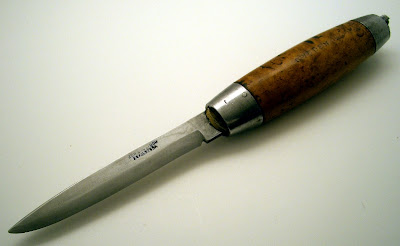




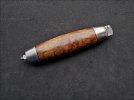
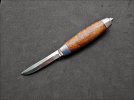
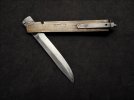
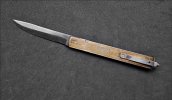
 Great pattern, but they've got very pricey these past few years
Great pattern, but they've got very pricey these past few years